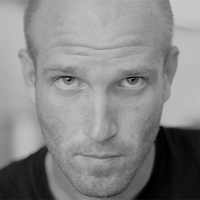NORTHFIELD, New Jersey — The last evidence of the life of Charles Richard Ingram III is a circle of scorched earth next to a Veterans Affairs clinic.
Ingram, a seven-year veteran of the U.S. Navy, arrived at the VA Community Based Outpatient Clinic around 1 p.m. on Saturday, March 19. He had been there before for treatment, but this would be his last visit.
The 51-year-old walked nine miles from his home in Egg Harbor, past an American Legion park and a memorial dedicated to military veterans, before finally stopping a few yards short of the clinic parking lot curb. Once there, he doused himself in gasoline and set himself on fire.
A motorist called 911, according to Capt. Paul Newman of the Northfield Police Department, and firefighters arrived three minutes later. A bystander was already at Ingram’s side, trying to extinguish the fire with blankets. Twenty minutes later, Ingram was airlifted to Temple University Burn Center in Philadelphia, where he died that evening.
“I’ve seen people die before with complications associated with minor burns, but he was 100 percent burned,” Northfield Assistant Fire Chief Lauren William Crooks told The Daily Beast. “Gasoline burns extremely hot, so how he survived the short time that he did was in my opinion a little unbelievable, but people react in unpredictable ways to trauma.”
Self-immolation accounted for 0.04 percent of all suicides in the United States in the past 15 years on record. (By comparison, firearms were used in approximately 50 percent of suicides.) The act is most commonly associated with protest, as in the iconic images of Buddhist monks in Tibet and South Vietnam.
Capt. Newman said he was supposed to have the afternoon off but was called in and arrived before Ingram was evacuated.
“Regardless of where you work, that’s a significant thing, one you hope to never have to see in your career,” he said.
On a recent day, a halo of black char crowned an arc of the oblong plot of black dirt in the otherwise verdant field outside the clinic. An oak tree’s trunk was ashen gray at the base and charcoal black above, the sole witness to Ingram’s suicide. The dirt had been raked and the mound dressed in flowers and flags.
Three floral bouquets were laid at the burnt edge next to a stylized cross; a crystal butterfly atop a thin wrought iron pedestal was flanked by two spotless American flags; a pinwheel with metallic red, white, and blue spokes stood beside another bouquet. Someone had placed a single empty bottle of pale ale in front of one of the flags. Altogether it would have resembled a solemn grave had it not been so strikingly scarred by the recent moment of violence there.
“Rich,” as he was known to family and friends, served in the Navy from 1985 to 1992, attaining the rank of chief petty officer. He left behind a wife, Billie, and two children, ages 3 and 5. The day before he killed himself, a local newspaper photographed the kids playing with other locals at nearby John F. Kennedy Park. Two days prior was his wife’s birthday; his daughter’s fourth birthday was two weeks away.
No one answered the door at the Ingram home in Egg Harbor Township on the Saturday afternoon one week after his death. The house number was short its last digit, which was peeling away from the mailbox, the front yard and porch were bare, and a pickup truck, bright white and freshly washed, was parked on the gravel drive beside the house. The blinds of the front window were unevenly gapped in half a dozen places as if habitually peeked through but never properly opened. (Family members said they were not ready to speak when reached by The Daily Beast via telephone.)
Ingram’s last years in the Navy were aboard the amphibious command ship the USS La Salle, one of five vessels in the Persian Gulf when Iraq invaded Kuwait in August 1990. Ingram stayed at sea throughout Operations Desert Shield and Desert Storm. He was chief on deck when the La Salle cruised into Ash Shuaybay, Kuwait, on March 12, 1991, the first American warship to enter the newly liberated port.
After retiring from the service, Ingram married Billie Bessler; the two lived briefly in Pennsylvania before settling in the house she still owns in Egg Harbor.
The clinic in Northfield is a community-based outpatient clinic of the VA Medical Center in Wilmington, Delaware. The VA’s Community Based Outpatient Clinics (CBOCs) serve patients in rural or remote locations who may not be able to travel to main hubs as a result of physical disabilities or psychiatric illnesses. Since most of the specialists, including psychiatrists, only see patients at the hub medical centers, CBOCs schedule “telehealth” appointments: closed-circuit “office visit” teleconferences. (Telehealth was first pioneered in combat medicine to provide troops in places like Afghanistan access to mental health services.) The approach is not intended to work like “phoning it in,” though: The VA’s guidelines for telehealth prescribe an intensive outpatient regimen of weekly sessions taking about five hours each. If Ingram received psychiatric services at the Northfield clinic, as Capt. Newman said, then it is likely he availed himself of telehealth or was waiting to do so.

A memorial service for Ingram is scheduled for April 2 at the United Methodist Church of Mantua. In lieu of flowers, donations can be made to Operation Smile.






